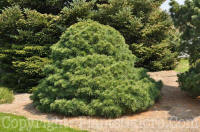 Traditionally, of course, pine trees
have been one of the most valued trees for their lumber.
Most houses in America have pine 2 by 4's or 2 by 6's
inside of every wall. They are also valuable when used
in the home landscape.
Traditionally, of course, pine trees
have been one of the most valued trees for their lumber.
Most houses in America have pine 2 by 4's or 2 by 6's
inside of every wall. They are also valuable when used
in the home landscape.
 Pines are native to a wide range of
the world including
North America,
Europe and
Asia. Most
of the species are trees but there are a few that grow
to large shrub size. Their leaves are in the form of
needles that appear in groups of 2, 3 or 5 from the
stem. The number of needles, their length and
flexibility along with the character of the cones are
key identification features of pines.
Pines are native to a wide range of
the world including
North America,
Europe and
Asia. Most
of the species are trees but there are a few that grow
to large shrub size. Their leaves are in the form of
needles that appear in groups of 2, 3 or 5 from the
stem. The number of needles, their length and
flexibility along with the character of the cones are
key identification features of pines.
The flowers of pines are
monoecious
meaning that they have separate male and female flowers
on the same plant. The female flowers when pollinated
become cones which are characteristic of each species. A
trained person can identify the pine species by the
cones alone.